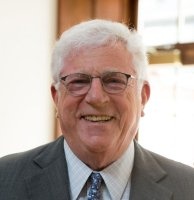Columbia College | Columbia University in the City of New York
Richard Ravitch ’55: Public Citizen Who Solved Financial Crises

Although he never won elective office (he was appointed New York’s lieutenant governor after Eliot Spitzer resigned in 2009 and David Paterson ’77 became governor), Ravitch was an effective behind-the-scenes political operative who left his mark on government in New York City and State. In 1975, he was recruited by Gov. Hugh Carey to stave off the financial collapse of New York’s Urban Development Corp. and, several months later, the city’s own fiscal crisis.
Born in Manhattan on July 7, 1933, Ravitch grew up on the Upper West Side with his father, Saul, who owned HRH Construction, and his stay-at-home mother, Sylvia, who played cello and was an accomplished sculptor. After graduating from Fieldston, he briefly attended Oberlin but transferred to the College as a first-year following the death of his father.
“My intellectual interests and political and social values came from my years at Columbia and began by being exposed to extraordinary people,” Ravitch told CCT in 2015, citing Lionel Trilling ’25, GSAS’38; Jacques Barzun ’27, GSAS’32; and Henry Graff GSAS’49, his adviser. He majored in history and focused on American politics, getting practical experience as co-chair of Students for Stevenson during Adlai Stevenson’s 1952 presidential campaign.
He graduated from Yale Law in 1958, was assistant counsel to a House military operations subcommittee in Washington, D.C., and served in the Army before joining the family construction business in New York. In the early 1960s, he partnered with Jim Scheuer to build the first integrated housing complex in D.C., and with Bayard Rustin and A. Phillip Randolph, he worked to desegregate the construction trades.
In his hometown, Ravitch was especially proud of developing Waterside Plaza, a complex of four large residential towers overlooking the East River. The project took 10 years from conception to completion in 1974.
In 1975, Carey tabbed Ravitch to rescue the near-bankrupt New York State Urban Development Corp. as its chairman. Afterward he was a key player in solving the city’s financial woes, working with Carey and others to prevent bankruptcy on several occasions. He also was instrumental in rescuing the decaying mass transit system in the 1980s as chairman of the Metropolitan Transportation Authority. Ravitch brought financial stability to the subway by negotiating legislative support, updating its fleet with stainless steel cars that could be cleaned of graffiti and brought the New Haven and New York Central commuter lines of Conrail under the MTA umbrella as Metro-North.
He retired from the MTA in 1983 but continued to utilize his skills as a financial fixer in both the public and private sectors. He led a group of investors who restored the ailing Bowery Savings Bank to profitability, and chaired a New York City charter revision commission that strengthened ethics and public campaign financing rules.
Ravitch’s influence extended well beyond New York. In the 1990s, as Major League Baseball’s chief negotiator, he proposed a revenue-sharing plan as well as a cap on players’ salaries, two innovations that became cornerstones in the sport’s subsequent growth. Together with Paul Volcker, a former chair of the Federal Reserve, he formed the State Budget Crisis Task Force in 2011 to draw attention to the fiscal vulnerabilities of governments across the country. And in 2014, he helped Detroit emerge from bankruptcy by advising the supervising judge about the feasibility of various plans and serving, at the request of the governor of Michigan, as senior adviser to Detroit’s Financial Review Commission, which oversaw the recovery.
In 2014, Ravitch authored So Much to Do: A Full Life of Business, Politics, and Confronting Fiscal Crises. The book is part memoir and part how-to for managing business and government fiscal challenges and chronicles his six decades of public service.
Ravitch was active in myriad New York civic organization, chairing and serving on the boards of Mount Sinai Hospital, the Volcker Alliance, Citizens Budget Commission, Jewish Community Relations Council of New York, Dalton School and Central Synagogue, among others.
Ravitch’s first two marriages, to Diane Silvers and Betsy F. Perry, ended in divorce. He is survived by his third wife, Kathleen M. Doyle; sons, Joseph (Sonya) and Michael (Daniel Hurewitz); daughters, Liz Doyle Carey (Alex), Carrie Doyle (Vasily Karasyov) and Laura Doyle (Zayd Hammam); and 13 grandchildren. He was predeceased by another son, Steven.
— Alex Sachare ’71
Issue Contents
Published three times a year by Columbia College for alumni, students, faculty, parents and friends.
Columbia Alumni Center
622 W. 113th St., MC 4530, 6th Fl.
New York, NY 10025
212-851-7852
cct@columbia.edu
Columbia Alumni Center
622 W. 113th St., MC 4530, 4th Fl.
New York, NY 10025
212-851-7488
ccalumni@columbia.edu

